In his 1981 memoir SHOCK VALUE, John Waters declared that “bad taste is what entertainment is all about … but one must remember that there is such a thing as good bad taste and bad bad taste.” I’m hard-pressed to find more compelling proof than Andrew Dominik’s ill-advised, ill-conceived, and just generally ill (derogatory) Marilyn Monroe quasi-biopic-on-acid BLONDE.
The film was heavily scrutinized before even Venice attendees laid eyes on the film. Monroe is a particularly tricky icon in our collective consciousness; her public persona serves as the thesis for decades of analysis on sex’s role in pop culture, while her troubled private life complicates that legacy with an all-too-easy tortured soul narrative. The mythos around Monroe has yet to arrive at anything resembling a conclusion, and it’s that multifacetedness that makes her so enduring. She was the embodiment of sex. She was playing a character and performing commentary on patriarchy. No one has ever been more glamorous than her. No one has ever been more tragic than her. Her impact is eternal. Her life was anything but.
So portraying her life—especially at a scale as grandiose as BLONDE’s nearly-three-hour runtime—is a formidable undertaking. To portray Monroe on film is to weigh in on the American experience as a whole, the way we treat women, and what culture even means. Dominik’s ambition is, on some levels, admirable. I’d even argue it’s necessary: for all of Monroe’s singular ubiquity, we still don’t have (and not for lack of trying) a defining work on the woman behind the character.
Unfortunately for Dominik, Ana de Armas, and everyone subjected to viewing this film, we’re going to have to keep waiting for said work. Frankly, I’m not sure where to begin with BLONDE, an instant contender for the worst movie I’ve ever seen and a shoo-in for the worst of the year. So much about the film is downright confounding, with countless left-field decisions punctuated by nervous laughter throughout my theater. For 10 or so minutes following the film’s conclusion, I was at a rare loss for words, and certainly not for lacking of wanting them.
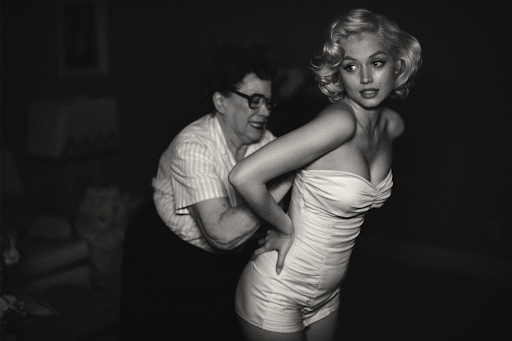
The Nude Thing
I suppose we’ll start here, with the only preconception I had going into the film. BLONDE is, for some reason, the first NC-17 film released on Netflix, as a result of its heavy nudity and sexual violence. De Armas’ nudity has been a hot topic for a while now; if there is one thing audiences generally know to expect from BLONDE, it is topless Ana de Armas. This in and of itself is hardly a red flag. Monroe is, of course, synonymous with sex. Arguably, a film that wasn’t racy would be more concerning because it would seem to ignore the truth about Monroe we hold to be self-evident.
It is with both relief and confusion that I offer: I’m not quite sure why BLONDE is NC-17 in the first place. The last NC-17 film I saw was Ninja Thyberg’s excellent PLEASURE (sidebar: this is available on Showtime, and I can’t recommend it enough), and BLONDE fails to measure up to that film’s purposeful raciness in any regard. Sure, de Armas is topless a lot (largely inexplicably, I’d add), and her Monroe receives her first role after a producer rapes her. But neither of these components feel particularly NC-17.
The nudity never lands as provocative or sexy; it’s not clear where the blame lies here—if de Armas is failing to evoke sex, if Dominik’s script isn’t giving her room to do so, or if the style just isn’t seductive enough. Regardless, the topless content all feels more convenient than sexually charged. When de Armas’ Monroe walks around topless, she does so in the way that one might walk around their studio apartment in their underwear. It’s unclear what Dominik gains from all this nudity. He and the film feel content to just let the sheer fact that their Monroe isn’t wearing clothes do the heavy lifting of raciness. I’d say it amounts to sexual empty calories, but the word “sexual” is doing too much work there for something so blasé.
On the note of the rape scene, there’s a disconnect between the objective horror of what transpires and the borderline glibness of how Dominik treats it. The event is fleeting, revisited once after its initial occurrence in flashback. Monroe shrugs it off, and Dominik is unexplainably at peace with following suit. For a moment that should feel like such a central trauma, BLONDE treats her rape almost like a throwaway. It’s a tricky area to broach, to be sure. In no way am I advocating for a film that lingers on the trauma of sexual violence, because that doesn’t serve anyone either, but when Dominik is so deeply indulgent with his faux-Lynchian attempts at evoking existential horror, it’s bizarre and frankly concerning just how little he seems to invest in the formative sexual violence in Monroe’s arc.
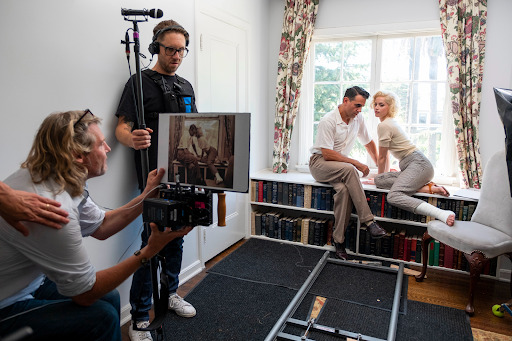
Evoking Marilyn
As Monroe, Ana de Armas has four emotional modes:
- Quietly forlorn, a bystander to her own circumstances. (This is her resting state.)
- Hysterical. (Think screaming, crying, usually in public.)
- Emma Roberts listening to “Happiness is a Butterfly”
- Sex
It’s remarkable, really, how little nuance exists in her performance when the movie is so goddamn long. I’m inclined to blame this on the script primarily, but I have to admit I’m perplexed by some of the praise de Armas is getting for this role. Throughout the film, her Monroe functions as a stick shift. In a given scene, we see her sticking steadfastly to one gear. There are happy scenes, there are freakout scenes, there are a lot of sort-of-sad scenes, and there are sex scenes. Rarely do we see her operate in more than one mode, and even then the shifts are abrupt. For a film with a nearly three-hour runtime, it is a considerable accomplishment to completely fail at tracking any nuanced emotional change. I’m almost impressed!
Perhaps what’s at the core of BLONDE’s mess is its utter failure to evoke the Marilyn of it all. Marilyn Monroe, as the kids would put it today, served cunt. Her presence was electrifying, knowingly sexy but with a quiet control over her most iconic moments. The Monroe BLONDE lets us see does not serve cunt. Sex scenes are not sexy, and perhaps that’s a specific choice meant to emphasize the way she was exploited, but, if so, it’s frankly a bad one. When de Armas recreates iconic Monroe performances, it feels hollow. These scenes are a poor substitute for archival footage, and the result lies squarely in the uncanny valley. That’s actually an operative space for the bulk of the film; from the very first shots, I felt an unplaceable off-ness about the script, as if it wasn’t quite human. The dialogue recalled the films of Nicolas Winding Refn in its approximation of a human film, as written by aliens.
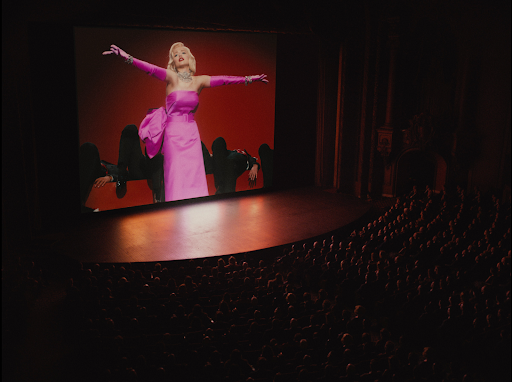
…Except NWR is stylistically cool.
I’m generally willing to forgive—or at least, live with—many flaws if a film is exciting cinematically. THE NEON DEMON, for instance, is a film I would never call “good” for the above alien-screenplay reasons, but it would be a massive disservice to ignore its thrillingly assured production design, style, and cinematography. I cannot say the same for BLONDE.
Dominik’s creative strategy seems to be a manic “yes, and.” He uses every trendy gimmick of the past 20 years, along with a few truly mind-boggling other inventions. The aspect ratio changes. The film oscillates between color and grayscale with no rhyme or reason. There are light leaks and lens flares. Scenes are deliberately unfocused. Color is deliberately desaturated at some points, technicolor at others. Faces are augmented. Footage is reused and warped. There is slo-mo. Other footage is sped up. Indulgent voice-overs punctuate the film. Time is sometimes non-linear. There are bizarre juxtapositions I can’t find it in me to put into words. The phone rings and rings and rings, and Dominik aggressively zooms in. There is a recurring motif of a CGI fetus. At one point, the fetus speaks. If I had a nickel every time there was a POV shot from her cervix, I would have 10 cents.
If this all sounds exhausting, that’s because it is. I’m hard-pressed to think of a film more hopelessly indulgent, artless, and over-the-top as BLONDE. And all in the service of… What, exactly? Just as the film’s failure to track any emotional change is a remarkable achievement in light of its scope, so is its dreadful pacing. Even with all that stylistic chaos, the film is interminable. Three hours feel like five. It’s hard to imagine how a film this overstimulating could simultaneously feel so unengaging. And yet!
Often when a movie fails and I don’t want it to, I remark that there’s a good film in there somewhere. As much as I wish that were true for Monroe’s sake, the fact of the matter is that BLONDE’s DNA is rotted. The film goes wrong in so many places that it’s nearly impossible to think of a world in which Dominik somehow salvaged his misguided, bloated, deranged mess of a film. Waters goes on to say that “to understand bad taste one must have very good taste.”
Andrew Dominik does not have very good taste.


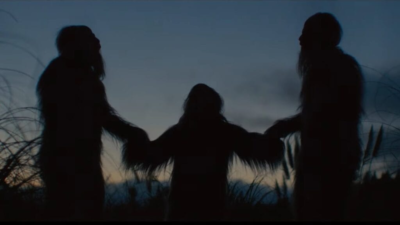

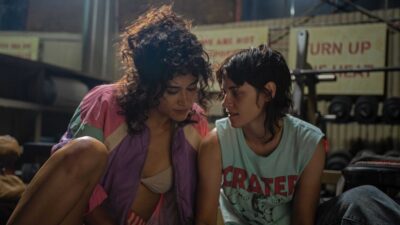










Comments